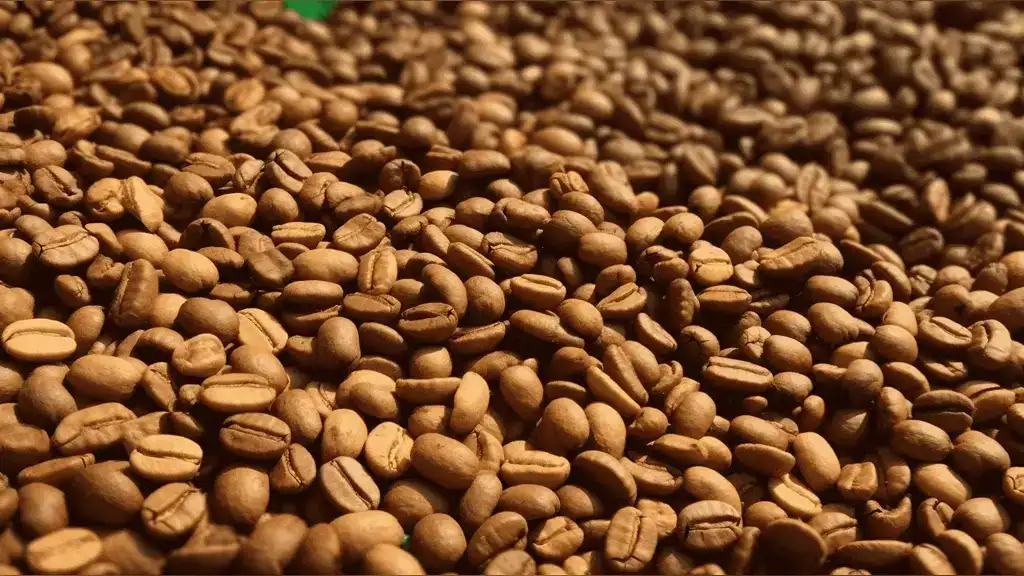When you think of honey processing coffee, what comes to mind? Most likely a style of coffee where the cherries are dried with the skin and pulp still on. This is known as pulped natural coffee, the other name of the honey processed coffee method.
In this blog post, we’ll explore the honey processing coffee method, from its history and benefits to how it’s made. Keep reading to learn more!
What is honey processed coffee?
While some may find the idea of honey processed coffee to be strange or off-putting, it can offer a unique and smooth taste experience. Honey refers to the sticky substance left on coffee cherries after they are dried, rather than adding sweetener.
By leaving this special layer on before roasting, the coffee beans absorb additional sweetness and a certain fruity flavor. This process also results in a lower acidity level, making it potentially easier on the stomach for those who are sensitive to acidity in coffee.
The honey processing technique combines elements of both washed and natural methods. With honey processing, the outer layer of the coffee cherry is removed, but some or all of the mucilage (the sticky substance surrounding the bean) is left intact.
This allows for some controlled coffee fermentation while also retaining some of the fruit flavors normally associated with natural processed coffees.
Why is it called honey processed coffee?
Contrary to popular belief, honey processed coffee does not contain any honey. So why is it given this sweet-sounding name?
The term “honey processed” refers to the method of removing the outer layer of fruit from the coffee beans.
While traditional wet processing removes this layer by washing it off with water, honey processing involves leaving some or all of the fruit on the bean and allowing it to dry before removal.
This technique results in a sweeter, more nuanced flavor that is reminiscent of honey. It’s a tricky process to perfect, as too much or too little remaining fruit can affect the flavor and aroma.
However, for those who enjoy a complex cup of coffee with notes of caramel and caramelized sugar, honey processed beans are a delicious choice.
Ancient cultures used various forms of honey processing long before modern technology allowed for wet processing methods, making it a time-honored tradition in the world of specialty coffee. While there may be no actual honey involved, this rare method certainly earns its tasty moniker.
Uncover the World of Coffee Processing with our Mastering Coffee Processing Techniques resource. Delight in the rich narratives of diverse methods, each contributing to the unique flavors in your cup. Join the exploration Exploring Coffee Processing Methods and brew knowledge like never before.
How long does honey process coffee take?
The length of honey processing varies depending on factors such as temperature and humidity, but typically it takes around 10-20 days before the beans are ready to be dried and roasted.
While this may take longer than other methods, honey processed coffees often have an extraordinary balance of sweetness and complexity that make it worth the wait.
Elevate your coffee knowledge with our honey processed coffee guide. Unearth the sweet nuances of this unique method and how it transforms your favorite brew. Get ready to embark on a flavor adventure that’s nothing short of extraordinary. Immerse yourself in the world of honey processed coffee at Natural Coffee Production Tips!
Is honey used in honey process coffee?
Honey is not used in honey process coffee. The name of the processing method refers to the sticky residue that is left on the coffee beans after they are dried, which can give them a sweet flavor.
Discover the intricacies of the washed coffee process, a method that meticulously cleans coffee cherries to produce a distinct flavor profile. Curious about the Most Expensive Bean Grading? Dive deeper into the luxury coffee realm and uncover the criteria that make some beans stand out.
What does honey processed coffee taste like?
Honey processed coffee typically has a sweet, fruity flavor with notes of caramel and caramelized sugar. This remarkable taste is the result of controlled fermentation and the retention of some fruit flavors normally associated with natural processed coffees.
What are the variants of honey processed coffee?
There are many different variants of honey processed coffee. While they all share the same basic processing method, there can be a lot of variation in the final product.
This makes it hard to know what to expect from a honey processed coffee, even if you’re familiar with other coffee types. In this blog section, we’ll take a closer look at the different types of honey processed coffee and what you can expect from each one.
There are four main variants of honey processed coffee: white honey, yellow honey, red honey, and black honey coffee process.
red honey coffee process
Red honey coffee is made by leaving half the mucilage (the sticky substance surrounding the coffee bean) on the bean during the drying process. This results in a sweeter, more nuanced flavor with notes of caramel and caramelized sugar.
The red honey process is the most difficult to perfect, as too much or too little mucilage can affect the flavor and aroma.
white honey coffee process
Unlike black honey processed coffees, which have the fruit left on during drying and add exceptional fruity notes, white honey coffees have most of the fruit removed before drying.
This leads to minimal mucilage remaining on the bean, resulting in a lighter body and a sweeter taste.
Since these coffees require less drying time and labor than the other processes, they can often be more affordable as well.
black honey process
The black honey process method requires more humidity and the development occurs at a slower pace.
This allows for the highest amount of mucilage – the sweet, sticky substance surrounding the coffee bean – to remain on the bean during drying.
This also means that black honey processed coffees require constant monitoring to prevent over-fermentation and mold from developing. The result of all this hard work? A richly flavored cup of coffee that is truly worth savoring.
yellow honey process
The yellow honey process is a method of removing the sticky mucilage from coffee beans during processing. It involves removing 50-75 percent of the mucilage, making it the least sticky of all honey processed coffees.
This results in a cleaner taste when prepared as a filter brew, and allows for more distinct flavor characteristics to shine through.
The yellow honey process also requires less manual labor than other honey processes such as black honey.
Overall, the yellow honey process strives for a balance between uncomplicated flavors and thoughtful effort in coffee processing.
The honey processed coffee Steps
- The first step is to remove the coffee cherry fruit from the coffee bean. This can be done by hand, or with a machine called a pulper.
After the coffee cherry fruit has been removed, the beans are sorted and graded.
- Remove the outer layer of the coffee bean, called the parchment layer. This can be done by machine or by hand.
- Remove the mucilage layer from the coffee bean. Mucilage is a sticky substance that covers the coffee bean.
- After the mucilage has been removed, the coffee beans are dried. This can be done in the sun or by a drying machine.
- The last step is to roast the coffee beans. This can be done in a roaster or in a home oven.
How to make honey processing coffee beans at home?
Assuming you would like a step-by-step guide on how to honey process coffee beans at home, the following outlines the process:
- First, you will need to acquire some green (unroasted) coffee beans. You can either purchase these from a specialty coffee shop or online.
- You will need to set up your workspace. This should be an area that is clean and well-ventilated. Make sure you have all of the necessary equipment and supplies within easy reach.
- Once everything is set up, begin by sorting through your coffee beans. Remove any beans that are damaged or defective.
- It’s time to start the actual honey processing. To do this, you will need to soak the coffee beans in water for 12-24 hours. The exact time will depend on the variety of beans and your personal preferences.
- After the beans have finished soaking, drain off the water and spread them out on a clean surface to dry.
- Remove the outer layer of the coffee bean: The coffee beans will now need to be stripped of their outer layers. This can be done by hand or with a machine.
- remove the mucilage layer from the coffee bean: This can be done by washing the beans with water or by using a special machine.
- If you are doing this by hand, the best way to do it is to rub the beans between your palms until the outer layer comes off.
- If you are using a machine, there are a few different ways to go about it. One common method is to use a de-huller. Another option is to use a wet grinder.
- Once the beans have been hulled, they will need to be dried again. This can be done in a food dehydrator or an oven set on the lowest possible setting.
- Once the beans are completely dry, they can be roasted. This can be done in a home roaster or a regular oven.
- Once the beans are roasted, they will need to be cooled and stored properly. The best way to do this is to allow them to sit out at room temperature for 24 hours. After that, they can be stored in an airtight container in a cool, dark place.
honey coffee process vs natural coffee process
The Honey coffee process is a type of semi-washed coffee processing. The coffee cherries are de-pulped and then dried with their mucilage intact. This sticky layer of fruit surrounding the bean imparts a sweetness to the coffee and can make it more full-bodied.
Natural coffees are made using the natural process, which involves drying the whole coffee cherries. This retains more of the fruit’s sugars, resulting in a sweeter cup of coffee. Natural coffees can also be more intense and fruity than honey coffees.
Ever been intrigued by the meticulous steps behind the washed coffee process? Dive into our Characteristics of Washed Coffee Guide and uncover the artistry that shapes your favorite brew’s taste and aroma.
semi washed coffee process vs honey coffee process
The semi-washed process is also known as the wet-hulled process. Coffee cherries are picked and then pulped to remove the skin and fruit. The coffee beans are then soaked in water for a short time before they are hulled, or stripped of their outer layer.
The coffee beans are then dried and roasted. This processing method produces coffee with a clean taste and bright acidity.
The honey process is a variation of the washed process. Coffee cherries are pulped and then the mucilage, or sticky substance around the bean, is removed. The coffee beans are then dried with the mucilage still on them.
This processing method produces coffee with a sweeter taste and more body. It also has lower acidity than coffee processed by the semi-washed method.
What equipment do you need for honey coffee processing?
To process honey coffee, you will need a coffee pulper, a drying rack, and a roasting machine.
The coffee pulper removes the skin and fruit from the coffee cherries. The dried mucilage is then removed from the beans by the roasting machine.
The drying rack is used to dry the coffee beans. The beans are placed on the rack and exposed to air until they reach the desired moisture content.
The roasted coffee beans are then ground and brewed.





![Coffee Processing Methods ([year]): Discover the Top Techniques! Coffee-Processing-Methods-Guide-1](https://coffeescan.com/wp-content/uploads/Coffee-Processing-Methods-Guide-1.webp)